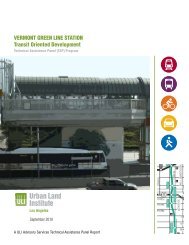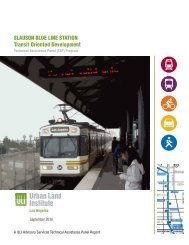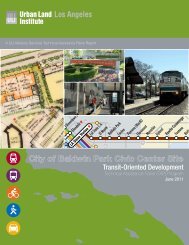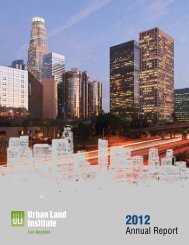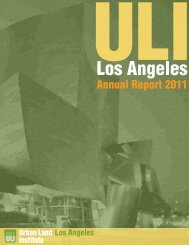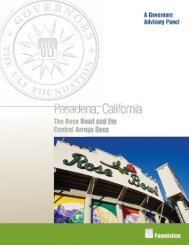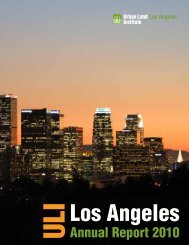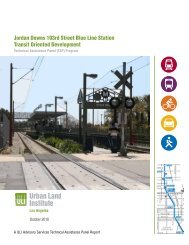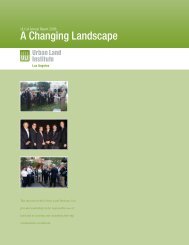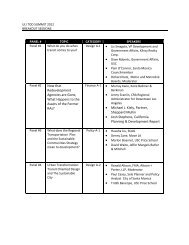Westchester Town Center - ULI Los Angeles - Urban Land Institute
Westchester Town Center - ULI Los Angeles - Urban Land Institute
Westchester Town Center - ULI Los Angeles - Urban Land Institute
Create successful ePaper yourself
Turn your PDF publications into a flip-book with our unique Google optimized e-Paper software.
A <strong>ULI</strong> AdvIsory servIces<br />
TechnIcAL AssIsTAnce PAneL rePorT<br />
<strong>Westchester</strong> <strong>Town</strong> <strong>Center</strong><br />
<strong>Los</strong> <strong>Angeles</strong>, California
©2009 by <strong>ULI</strong>—the <strong>Urban</strong> <strong>Land</strong> <strong>Institute</strong><br />
1025 Thomas Jefferson Street, NW<br />
Suite 500 W<br />
Washington, DC 20007<br />
All rights reserved. Reproduction or use of the whole or any part of the contents<br />
without written permission of the copyright holder is prohibited.
<strong>Westchester</strong> <strong>Town</strong> <strong>Center</strong><br />
Technical Assistance Panel<br />
report for<br />
The <strong>Westchester</strong> Business<br />
Improvement District<br />
February 27, 2009<br />
<strong>ULI</strong> <strong>Los</strong> <strong>Angeles</strong><br />
<strong>Los</strong> <strong>Angeles</strong> District Council of the <strong>Urban</strong> <strong>Land</strong> <strong>Institute</strong><br />
Panel Members and Committee: Jim Kumon, Bob Gardner, John Fransen, Richard Thompson, Donald<br />
Brackenbush, Neal Payton, Javier Mariscal, Ned Fox, Bill Fulton, Jonathan Curtis, Donald Duckworth,<br />
and Robin Baral.<br />
<strong>ULI</strong> <strong>Los</strong> <strong>Angeles</strong><br />
444 South Flower Street, Suite 3880<br />
<strong>Los</strong> <strong>Angeles</strong>, California 90071<br />
i
Acknowledgements<br />
The panelists and <strong>ULI</strong> <strong>Los</strong> <strong>Angeles</strong> wish to thank the <strong>Westchester</strong> Business<br />
Improvement Association for requesting the panel to provide advice and<br />
guidance regarding the future of <strong>Westchester</strong> <strong>Town</strong> <strong>Center</strong>. The panel could<br />
not have proceeded in this endeavor without the support of Donald Duckworth,<br />
Executive Director for the <strong>Westchester</strong> Business Improvement District. Thank<br />
you to Javier Mariscal, Donald Brackenbush, and Sadie Carver of Public<br />
Private Ventures for guiding the development of the written report. Also thanks<br />
to William Whitney, Whitney & Whitney; Joseph Fahey, Lupert Adler West;<br />
Chris Alford, Otis College; David Voss, Esq. Airport Relations Committee of<br />
LAX Coastal Communities Chamber of Commerce; Gordon Hamilton and<br />
Betsy Weisman, City of <strong>Los</strong> <strong>Angeles</strong> Planning Department; Bob Tarnofsky,<br />
Continental Development Corporation; and David Flaks, LAEDC for their time<br />
in serving as resources.<br />
ii
<strong>ULI</strong> Advisory Services<br />
and the Technical Assistance Panel Program<br />
The goal of <strong>ULI</strong>’s Advisory Services Program is to bring the finest expertise<br />
in the real estate field to bear on complex land use planning and development<br />
projects, programs, and policies. Since 1947, this program has assembled well<br />
over 500 <strong>ULI</strong> member teams to help sponsors find creative, practical solutions<br />
for such issues as downtown redevelopment, land management strategies,<br />
evaluation of development potential, growth management, community<br />
revitalization, brownfields redevelopment, military base reuse, provision of<br />
low-cost and affordable housing, and asset management strategies, among<br />
other matters. A wide variety of public, private, and nonprofit organizations<br />
have contracted for <strong>ULI</strong>’s Advisory Services.<br />
Each team is composed of highly<br />
qualified professionals who volunteer<br />
their time to <strong>ULI</strong>. They are chosen<br />
for their knowledge of the topic and<br />
screened to ensure their objectivity.<br />
<strong>ULI</strong> teams are interdisciplinary<br />
and are developed based upon the<br />
specific scope of the assignment. They<br />
provide a holistic look at development<br />
problems. A respected <strong>ULI</strong> member<br />
with previous panel experience chairs<br />
each team.<br />
Technical Assistance Panels, or TAPs, are conducted by the local District<br />
Council level of <strong>ULI</strong>. <strong>ULI</strong> <strong>Los</strong> <strong>Angeles</strong> has been at the forefront in creating<br />
the TAP program, offering the expertise of local <strong>ULI</strong> members to local<br />
government and nonprofit entities through one or two day panels. The TAP<br />
Program guidelines are the same as those that govern the entire Advisory<br />
Services Program.<br />
To date, <strong>ULI</strong> <strong>Los</strong> <strong>Angeles</strong> has conducted Technical Assistance Panels for the<br />
City of Beverly Hills, City of Culver City, City of Pasadena, City of Whittier,<br />
University of Southern California, the <strong>Los</strong> <strong>Angeles</strong> Conservancy, the Ports<br />
O’Call Village, First United Methodist Church of <strong>Los</strong> <strong>Angeles</strong>, and The Canaan<br />
Group, among others.<br />
A key strength of the program is <strong>ULI</strong>’s unique ability to draw upon the<br />
knowledge and expertise of its members, including land developers and owners,<br />
public officials, academics, representatives of financial institutions, and others.<br />
In fulfillment of the <strong>Urban</strong> <strong>Land</strong> <strong>Institute</strong>’s mission, this TAP report is intended<br />
to provide objective advice that will promote the responsible use of land and in<br />
creating and sustaining thriving communities.<br />
iii<br />
Javier Mariscal introduces the panel assignment<br />
and objectives.
For more information about how a <strong>ULI</strong> <strong>Los</strong> <strong>Angeles</strong> Technical Assistance Panel<br />
could benefit your city or nonprofit organization, contact Christine Aure, Project<br />
Manager, at Aure@uli-la.org or Jonathan Curtis, <strong>ULI</strong> TAP Committee Chair<br />
from Trevear Holdings, at Joncurtis@sbcglobal.net.<br />
For more information about <strong>ULI</strong> <strong>Los</strong> <strong>Angeles</strong>, a District Council of the <strong>Urban</strong><br />
<strong>Land</strong> <strong>Institute</strong>, contact Katherine Perez, <strong>ULI</strong> <strong>Los</strong> <strong>Angeles</strong> Executive Director, at<br />
Perez@uli-la.org, or the <strong>ULI</strong> LA website, www.uli-la.org.<br />
iv<br />
<strong>ULI</strong> Project Staff<br />
Thomas W. Eitler<br />
Vice President<br />
<strong>Urban</strong> <strong>Land</strong> <strong>Institute</strong><br />
Katherine Aguilar Perez<br />
Executive Director<br />
<strong>ULI</strong> <strong>Los</strong> <strong>Angeles</strong><br />
Jonathan Curtis<br />
<strong>ULI</strong> TAP Committee Chair<br />
Trevear Holdings<br />
Christine Aure<br />
Project Manager<br />
<strong>ULI</strong> <strong>Los</strong> <strong>Angeles</strong><br />
Ciara Contreras<br />
Project Assistant<br />
<strong>ULI</strong> <strong>Los</strong> <strong>Angeles</strong><br />
Sadie Carver<br />
Editorial Consultant<br />
Project Assistant, Public Private Ventures<br />
John Dlugolecki<br />
Photographer<br />
Robin Baral<br />
Transcriber<br />
Student, Loyola Law School
Contents<br />
Acknowledgements ii<br />
<strong>ULI</strong> Advisory Services iii<br />
Introduction 3<br />
Regional Context 7<br />
The <strong>Westchester</strong> <strong>Town</strong> <strong>Center</strong> 12<br />
Recommendations 17<br />
Panel Members 23<br />
1<br />
South entrance into the town center.<br />
Panel Members touring the site area
Introduction<br />
The <strong>Westchester</strong> Business Improvement<br />
District (BID) engaged the <strong>Los</strong><br />
<strong>Angeles</strong> District Council of the <strong>Urban</strong><br />
<strong>Land</strong> <strong>Institute</strong> (<strong>ULI</strong> LA) to convene<br />
a Technical Assistance Panel (TAP)<br />
to advise the BID on the preparation<br />
of a vision that maximizes the future<br />
opportunities as a neighborhood<br />
and regional center and to provide<br />
recommendations for implementation.<br />
The following report presents the<br />
findings and conclusions of the<br />
<strong>Urban</strong> <strong>Land</strong> <strong>Institute</strong> Technical<br />
Panel (<strong>ULI</strong> TAP) of the <strong>Los</strong> <strong>Angeles</strong><br />
District Council regarding its initial<br />
perception of the future opportunities<br />
and constraints facing the <strong>Westchester</strong><br />
Business Improvement District (BID).<br />
The TAP, comprised of a group of<br />
planning and real estate professionals<br />
who volunteered their services for a<br />
one-day charrette to study the District,<br />
were initially provided a briefing<br />
document that included land use<br />
information covering the BID and<br />
demographic materials that described<br />
the market potentials of the larger<br />
<strong>Westchester</strong> community.<br />
The Panel gathered additional<br />
information from interviews held with<br />
local public planning officials and<br />
private real estate owners active in<br />
the local area, and toured the BID in<br />
order to better understand its physical<br />
character and evaluate existing<br />
conditions. Following these intensive<br />
reviews, they proposed a series of<br />
ideas that would promote positive<br />
change in support of the BID’s stated<br />
goals and objectives.<br />
The Panel members are all based<br />
in southern California and very<br />
knowledgeable about local conditions.<br />
In this regard, they recognize the<br />
unique position of the <strong>Westchester</strong> BID<br />
as a community-serving commercial<br />
district that is juxtaposed immediately<br />
3<br />
Loyola Theater serves as a medical office building<br />
today.<br />
<strong>Westchester</strong> pays tribute to LAX and its ties to<br />
aviation history.<br />
Panel Members getting the pedestrian experience<br />
on Sepulveda Boulevard.
Neal Payton explores design improvements for<br />
the area.<br />
Panel Members tour the site area with<br />
representatives from OTIS College, the City of <strong>Los</strong><br />
<strong>Angeles</strong>, and the <strong>Westchester</strong> BID.<br />
adjacent to <strong>Los</strong> <strong>Angeles</strong> International<br />
Airport, perhaps the most significant<br />
economic “engine” in the entire region.<br />
The airport is currently undergoing a<br />
planning process that may lead to its<br />
significant expansion, thus potentially<br />
impacting surrounding communities.<br />
Hopefully, the Panel’s report will<br />
assist the BID in its determination of<br />
an appropriate future that can both<br />
accommodate LAX expansion and<br />
lead to its successful evolution as an<br />
enhanced “<strong>Westchester</strong> <strong>Town</strong> <strong>Center</strong>”.<br />
Technical<br />
Assistance Panels<br />
In keeping with <strong>ULI</strong>’s mission,<br />
Technical Assistance Panels are<br />
convened to provide pro-bono planning<br />
and development assistance to public<br />
officials and local stakeholders of<br />
communities and nonprofit organizations<br />
who have requested assistance in<br />
addressing their land use challenges.<br />
A group of diverse professionals<br />
4<br />
representing the full spectrum of land<br />
use and real estate disciplines typically<br />
spend one day visiting and analyzing the<br />
built environments, identifying specific<br />
planning and development issues, and<br />
formulating realistic and actionable<br />
recommendations to move initiatives<br />
forward in a fashion consistent with the<br />
applicant’s goals and objectives.<br />
Panel of Experts<br />
and TAP Process<br />
Panel Members<br />
<strong>ULI</strong> convened a panel of professionals<br />
who represent a variety of disciplines<br />
connected with land use and real estate<br />
development, such as planning, urban<br />
design, commercial office leasing, retail<br />
center operation, real estate brokerage<br />
and airport planning/impact analysis.<br />
Members were selected with the intent of<br />
convening a robust array of professional<br />
expertise relevant to the BID’s objectives<br />
for the study and who had local working<br />
knowledge of this sub-region. Panel<br />
members included the following:<br />
Javier Mariscal, AICP, Project<br />
Principal, Public Private Ventures<br />
Donald Brackenbush, Principal,<br />
Public Private Ventures<br />
Ned Fox, Partner, Vantage Property<br />
Investors, LLC.<br />
John A. Fransen, President, The<br />
Fransen Company<br />
Left to right: Bill Fulton, Jim Kumon, Richard<br />
Thompson, Ciara Contreras, Ned Fox, John Fransen,<br />
Robin Baral, Neal Payton, and Javier Mariscal.
Bill Fulton, Principal, Design<br />
Community & Environment (DCE)<br />
Jim Kumon, Project Manager,<br />
Miralles Associates<br />
Neal I. Payton, AIA, Senior Principal,<br />
Torti Gallas and Partners, Inc.<br />
Neil Resnick, Executive Vice<br />
President—Transaction Services,<br />
Grubb & Ellis<br />
Richard W. Thompson, FAIA, AICP,<br />
Principal, AC Martin Partners, Inc.<br />
TAP Process & Objectives<br />
Panel Members tour the site area with<br />
representatives from OTIS College,<br />
the City of <strong>Los</strong> <strong>Angeles</strong>, and the<br />
<strong>Westchester</strong> BID.<br />
Upon the submission of the TAP<br />
request, <strong>ULI</strong> representatives met with<br />
the <strong>Westchester</strong> Business Improvement<br />
District to determine the scope of<br />
the panel assignment. The panel was<br />
selected based upon their ability to<br />
address the stated objectives for the<br />
program provided by the BID:<br />
To develop a Vision for the<br />
<strong>Westchester</strong> Business Improvement<br />
District (BID) that maximizes the<br />
future opportunities that exist by<br />
serving as the town center for the<br />
<strong>Westchester</strong>/Playa del Rey market<br />
area and the “Gateway” to the LAX<br />
North Side Area; and<br />
To prepare a “Road Map” for<br />
the implementation of these<br />
future opportunities through the<br />
establishment of appropriate<br />
linkages with LAWA and the<br />
<strong>Westchester</strong> community.<br />
The <strong>Westchester</strong> BID provided<br />
background materials that were<br />
distributed to the Panel in advance.<br />
The Chair of the Panel and the TAP<br />
Committee were briefed on the issues<br />
by the BID Executive Director,<br />
Donald Duckworth.<br />
On February 27, 2009, the panel<br />
convened for the one-day panel. The<br />
panel began with a tour of the site<br />
and a briefing with the BID director.<br />
Representatives from OTIS College,<br />
the City of <strong>Los</strong> <strong>Angeles</strong>, Continental<br />
Development Corporation, and local<br />
stakeholders participated in a short<br />
interview session. Panel members<br />
engaged in informal discussions<br />
regarding issues and opportunities.<br />
Panel’s Assignment<br />
The <strong>Westchester</strong> BID requested that<br />
the <strong>ULI</strong> LA Technical Assistance Panel<br />
consider the BID’s future opportunities<br />
given its unique location adjacent to<br />
the <strong>Los</strong> <strong>Angeles</strong> International Airport<br />
(LAX); the anticipated future land use<br />
of the area north of LAX; the potential<br />
north runway expansion plans of LAX;<br />
and traffic congestion. To this end, the<br />
BID leadership identified the following<br />
major issues that it believed the TAP<br />
should consider while addressing the<br />
future of the District:<br />
What should be the future land use<br />
profile of the <strong>Westchester</strong> BID area,<br />
given its unique location adjacent to<br />
<strong>Los</strong> <strong>Angeles</strong> International Airport<br />
(LAX) and its critical role as a<br />
commercial service center for the<br />
<strong>Westchester</strong> community? What<br />
types of businesses and/or industries<br />
should be encouraged in the future?<br />
5<br />
Ned Fox reviews the final presentation with Ciara<br />
Contreras and Christine Aure.
Bill Fulton explains the unique political dynamics<br />
of the region <strong>Westchester</strong> faces.<br />
Ned Fox discusses opportunities for <strong>Westchester</strong> <strong>Town</strong> <strong>Center</strong><br />
<strong>Los</strong> <strong>Angeles</strong> World Airports<br />
(“LAWA”) owns 350+/- acres of<br />
vacant land known as the North Side<br />
Development Area that is contiguous<br />
to the BID, and is entitled for office,<br />
industrial, hotel and retail uses.<br />
What steps should be taken to ensure<br />
that the North Side is developed in<br />
a manner that is beneficial to the<br />
<strong>Westchester</strong> Business District and<br />
the local community?<br />
Prior expansion activities at LAX<br />
related to the North Runway have<br />
negatively impacted the <strong>Westchester</strong><br />
BID by reducing its local customer<br />
base and removing businesses<br />
in the Sepulveda Corridor via<br />
property acquisitions. At present,<br />
new airport expansion initiatives<br />
are being considered that could take<br />
additional properties and jeopardize<br />
the economic viability of the entire<br />
District. What measures can the<br />
District take in order to help LAX<br />
find planning solutions that are “win-<br />
6<br />
win” with respect to their impact on<br />
the airport and the local community?<br />
Traffic congestion in the<br />
<strong>Westchester</strong> Business District<br />
is a significant impediment to<br />
the successful functioning of<br />
local businesses, residents, LAX<br />
operations and the traveling public.<br />
How can traffic congestion be<br />
managed for the benefit of all these<br />
different interests? Is there any<br />
possibility for introducing some<br />
form of light transit to the area<br />
that could serve the needs of both<br />
<strong>Westchester</strong> and LAX?<br />
Are residential uses appropriate<br />
for the <strong>Westchester</strong> BID given<br />
modern building technologies and<br />
the view opportunities?<br />
What innovative funding approaches<br />
for the implementation of the vision<br />
and the “Road Map” should be<br />
considered by the BID?
Regional Context<br />
The <strong>Westchester</strong> Community<br />
The <strong>Westchester</strong> BID is located in the Community of <strong>Westchester</strong> that is part of<br />
the City of <strong>Los</strong> <strong>Angeles</strong>. It is comprised of 120 properties that straddle Sepulveda<br />
Boulevard between Manchester Avenue on the north and the northern boundary<br />
of LAX and Lincoln Boulevard on the south. The district’s regional location is<br />
shown in Figure 1.<br />
The positioning of the BID on Sepulveda Boulevard, an important north-south<br />
arterial that both directly serves to LAX as well as connects the South Bay with<br />
West <strong>Los</strong> <strong>Angeles</strong> to the South Bay and beyond, is both a blessing and a curse.<br />
Figure 1: Regional Context<br />
7
Entrance sign to the <strong>Los</strong> <strong>Angeles</strong><br />
International Airport<br />
On the day of the panel, construction crews were<br />
busy completing sidewalk improvements and<br />
planting trees.<br />
Former Mervyn’s site on Sepulveda Boulevard to<br />
be occupied by Kohl’s in late 2009.<br />
Sepulveda serves as an important feeder street to the airport and thus offers<br />
an economic opportunity of sorts for the BID to be considered a “Northern<br />
Gateway” to and from LAX, it is heavily-travelled by automobiles passing<br />
through the district as an alternative to the freeway system.<br />
This condition is made worse by the east-west configuration of LAX, which<br />
effectively forces north-south traffic on regional roads such as La Tijera<br />
Boulevard and Lincoln Boulevard to be funneled onto Sepulveda at intersections<br />
that are located in or adjacent to the BID, further exacerbating local traffic<br />
conditions at the peak periods. Access to the BID is also provided by Manchester<br />
Avenue and <strong>Westchester</strong> Parkway that generally flow in an east-west direction<br />
through the <strong>Westchester</strong> Community.<br />
Immediate Neighborhood Environment<br />
The <strong>Westchester</strong> BID serves as a community and neighborhood shopping<br />
center for a residential population of nearly 42,000 persons. At the present time<br />
<strong>Westchester</strong> is undergoing substantial upgrading by younger households who are<br />
attracted to one of the few remaining affordable residential locations that is both<br />
near the ocean yet still highly accessible to major employment centers that are<br />
located northerly of LAX along the Wilshire Corridor<br />
In terms of abutting neighborhoods, the <strong>Westchester</strong> Community is bounded by the<br />
Playa Del Rey Community on the west; the developing community of Playa Vista<br />
and the City of Culver City on the north; and the City of Inglewood on the east. Two<br />
large educational institutions make their home in <strong>Westchester</strong>, Loyola Marymount<br />
University and Otis College. <strong>Westchester</strong> is connected to other parts of the <strong>Los</strong><br />
<strong>Angeles</strong> region by the I-405 and I-105 Freeways. Public transportation includes bus<br />
rapid transit. Some planning concepts recommend the extension of the Metro Green<br />
Rail Line to LAX, then northerly to the immediate vicinity of the BID.<br />
<strong>Westchester</strong> <strong>Town</strong> <strong>Center</strong>’s Assets<br />
and Strengths<br />
<strong>Westchester</strong> <strong>Town</strong> <strong>Center</strong> has a unique location and an important economic<br />
opportunity associated with its immediate adjacency to LAX, as it offers the<br />
first and last contact point for many thousands of travelers venturing in and out<br />
of southern California. In addition, the BID is bounded on the north and west<br />
by the stable and affluent <strong>Westchester</strong> residential neighborhoods. The following<br />
summarize the special strengths of the BID:<br />
8
South entrance into the town center.<br />
Business Improvement District<br />
The <strong>Westchester</strong> Business Improvement District (BID) was borne out<br />
of a public-private partnership with the City of <strong>Los</strong> <strong>Angeles</strong> for local<br />
commercial property owners to provide for landscape maintenance along<br />
Sepulveda Boulevard in exchange for the City’s funding of an $11.6 million<br />
infrastructure project. The existence of this entity is an excellent catalyst<br />
for revitalization. A business improvement district provides the leadership,<br />
organizational structure, and a continuous revenue stream for revitalization of<br />
the district.<br />
Functioning Business Corridor<br />
Along Sepulveda Boulevard the <strong>Westchester</strong> BID is home to a number of national<br />
and regional retailers, and is fortunate that the former Mervyn’s retail space will<br />
be re-occupied by a Kohl’s Department Store by the end of 2009. In the eastern<br />
87th Street Triangle, the district also has a variety of thriving small businesses.<br />
Otis College of Art and Design<br />
Otis College of Art and Design wishes to expand its operations in the<br />
<strong>Westchester</strong> community. Otis moved from the Mid-Wilshire area in 1997 to<br />
<strong>Westchester</strong>, and has slowly grown from 600 to more than 1200 students. As the<br />
college plans to further expand its campus, Otis is evaluating its alternatives,<br />
and is negotiating with LAWA for a six- to eight-acre site in the North Side<br />
Development Area. Otis plans to build a campus of one- and two-story<br />
9<br />
John Fransen discusses the BID’s challenges.
Javier Mariscal brings together key ideas and<br />
strategies.<br />
Figure 2: North Side Development Zones<br />
buildings scattered along the site with a greenbelt. The school is also interested<br />
in creating a street scene presence and enhancing its overall visibility in the<br />
community, and might consider some form of presence in the BID.<br />
Extension of Transit Lines<br />
Expansion of LAX will likely include the extension of the Green Line into the<br />
main terminal area. Given this proximity, it may be possible to further extend<br />
transit into the <strong>Westchester</strong> area where it could serve the BID. Such expansion of<br />
the Green Line would also encourage the addition of businesses and jobs in the<br />
North Side Area with minimal impact on automobile traffic in <strong>Westchester</strong> and<br />
surrounding communities.<br />
LAX North Side Development Area<br />
LAX North Side Development Area is a 350 acre strip of largely-developable<br />
land that borders the <strong>Westchester</strong> BID along Sepulveda Westway between La<br />
Tijera Boulevard and 92nd Street. The property is owned by LAWA and serves as<br />
a buffer between the North Runway and the <strong>Westchester</strong> Community.<br />
The North Side has been planned and entitled for 4.3 million to 5.0 million<br />
square feet of commercial and related development area1. Development of this<br />
1 While planning documents indicate that the development potential of the North Side Development Area ranges from<br />
4.3 million to 5.0 million square feet based upon traffic limitations, informal discussions with planners familiar with the<br />
EIR process for LAX expansion suggest that development potential is more likely in the 2.0 million square foot range.<br />
10
property could have a significant impact on the vitality of the BID by adding to<br />
the attractions found in or near the District and expanding the customer base.<br />
The property is increasingly recognized by the City of <strong>Los</strong> <strong>Angeles</strong> as a highly<br />
suitable location for new businesses, thus represents a potential employment<br />
center that could be one of the keys to future economic growth in the region. The<br />
North Side Development Area Design Plan is shown in Figure 2.<br />
11<br />
Panel members touring the site area.<br />
Ralphs Shopping <strong>Center</strong><br />
Northern section of Sepulveda Boulevard
Retail stores on Sepulveda Boulevard.<br />
Commercial buildings on Sepulveda featuring Bed<br />
Bath & Beyond, Starbucks, and Wachovia Bank.<br />
Long-term airport parking facility on<br />
Sepulveda Boulevard.<br />
The <strong>Westchester</strong> <strong>Town</strong> <strong>Center</strong><br />
Characteristics<br />
According to the <strong>Westchester</strong> / Playa<br />
del Rey Community Plan, <strong>Westchester</strong><br />
is a community serving commercial<br />
area. Accordingly, the district is<br />
characterized by mostly one and twostory<br />
commercial retail structures,<br />
though there are several multi-story<br />
buildings that are occupied by general<br />
and medical office users.<br />
Based upon recent surveys completed<br />
in early 2009, the existing building<br />
space in the district is occupied by<br />
the following major activities: Retail,<br />
38%; Eating and Drinking Facilities,<br />
11%; Services, including auto-related,<br />
13%; Medical-Dental, Offices, 20%;<br />
and General Office, 19%. Despite<br />
the current economic conditions, the<br />
vacancy rate for existing space is at<br />
2%, which is very low relative to other<br />
parts of the City of <strong>Los</strong> <strong>Angeles</strong> at<br />
about two percent.<br />
Collectively, the retail space is<br />
somewhat characteristic of a large<br />
12<br />
community/sub-regional shopping<br />
center, though there are several large<br />
stores that serve the needs of local<br />
businesses. Retailers include well<br />
known national and regional chain<br />
stores, such as CVS Drugs; Trader<br />
Joe’s; Office Depot; Petco; Bed Bath<br />
and Beyond; and Staples. These<br />
retailers have generally selected highervisibility<br />
locations on Sepulveda<br />
Boulevard. Smaller, locally-owned<br />
businesses have clustered in the 87th<br />
Street / La Tijera Boulevard triangle.<br />
The existing distribution of the<br />
490,000 square feet of office space is<br />
43% general office use, 13% financial<br />
services, and 44% medical services.<br />
It is also important to note that other<br />
than a few automobile–related activities<br />
such as long-term parking lots and<br />
rental car facilities there are very few<br />
uses that are obviously taking advantage<br />
of proximity to the airport or would<br />
logically appeal to the visitor market.<br />
<strong>Westchester</strong> Business<br />
Improvement District<br />
(BID)<br />
Originally conceived by local<br />
commercial property owners as<br />
a means to provide for landscape<br />
maintenance along Sepulveda<br />
Boulevard as part of a public-private<br />
partnership with the City of <strong>Los</strong><br />
<strong>Angeles</strong>, the <strong>Westchester</strong> Business<br />
Improvement District (BID) was<br />
established in July 2007 with a<br />
substantially broader purpose of<br />
enhancing the commercial vitality<br />
of the <strong>Westchester</strong> area. In its first<br />
Strategic Plan, the BID’s Board of
Directors established the following<br />
objectives for the organization:<br />
1. Identifying a future development<br />
program that will provide<br />
optimum returns for BID property<br />
owners and accommodate LAX<br />
expansion requirements.<br />
2. Seeking ways to mitigate the<br />
historic and possible future<br />
negative impacts from LAX<br />
expansion on the BID.<br />
13<br />
Figure 3: Design concept alternative ideas
Unmanaged off-street parking on the Sepulveda<br />
Eastway.<br />
Retail stores on Sepulveda Boulevard.<br />
Traffic on Sepulveda Boulevard.<br />
Parking on south end of Sepulveda Eastway.<br />
3. Providing substantive input to<br />
the planning for the North Side<br />
Development Area to ensure it<br />
will be beneficial to the BID and<br />
the larger community.<br />
4. Finding approaches to relieve local<br />
traffic congestion through such<br />
measures as extending the Green<br />
Line to LAX and to the BID.<br />
The <strong>Westchester</strong> BID covers 120<br />
parcels of land that encompass 46.05<br />
acres or 2,006,074 square feet of area.<br />
Based upon recent surveys, the existing<br />
building space exclusive of parking<br />
structures is estimated at 1,096,883<br />
square feet. The geographic boundaries<br />
of the <strong>Westchester</strong> BID are identified<br />
in Figure 3, while the individual<br />
properties that comprise the District<br />
are delineated in Figure 4.<br />
Downtown Concerns<br />
and Challenges<br />
Throughway<br />
As the Panel observes, <strong>Westchester</strong><br />
suffers from the use of Sepulveda as<br />
an alternative to the I-405 Freeway<br />
14<br />
and as a major entry road to LAX.<br />
As a result, the road carries a<br />
disproportionate amount of through<br />
traffic as people are proceeding from<br />
destinations north and south of the<br />
airport to those at the airport and other<br />
parts of the region. The challenge<br />
for <strong>Westchester</strong> is to mitigate the<br />
effects of through traffic so that it can<br />
better serve its customer base. It also<br />
needs to consider how it can convert<br />
communities into customers.<br />
It is also important to recognize that<br />
the width of Sepulveda Boulevard<br />
as a regional arterial together with<br />
the high traffic volumes present<br />
significant issues to planning the BID<br />
as a single physical space. Over time,<br />
it may be important to recognize that<br />
the planning of the District requires<br />
consideration of separate solutions for<br />
each side of this major street.<br />
LAX North Runway<br />
Expansion/<br />
Reconfiguration<br />
In March 2008, the <strong>Los</strong> <strong>Angeles</strong><br />
World Airports (LAWA) published<br />
a Notice of Preparation of a Draft
Environmental Impact Report<br />
(DEIR) which includes alternative<br />
development plans to reconfigure<br />
the north runway. Alternatives under<br />
consideration range from keeping the<br />
existing runway in its current location<br />
to moving it northerly as much as 340<br />
feet. Moving the runway northerly<br />
toward the BID could require<br />
the taking of properties and the<br />
re-design of the circulation system,<br />
this scenario could negatively affect<br />
the economic performance of the<br />
BID. While timelines are reportedly<br />
slipping, the DEIR is scheduled for<br />
release in August 2009, then faces a<br />
significant period of review before<br />
adoption and a final determination of<br />
the runway alignment.<br />
LAWA’s unknown intentions and<br />
uncertain schedule for making a<br />
final decision regarding the North<br />
Runway’s alignment—not to mention<br />
possible changes in the roadway<br />
circulation system, the configuration<br />
of future parking lots, locations of<br />
rental car operations and even the<br />
alignment of the Green Line—provide<br />
severe challenges to the BID as it<br />
attempts to plan for its future.<br />
Parking<br />
The Panel recognizes that the BID is<br />
well aware of a number of parking<br />
issues facing the District, and also<br />
notes that parking studies are under<br />
way that should lead to solutions to<br />
the current problems. It is unfortunate<br />
that these studies were not completed<br />
prior to the TAP, as they might<br />
have been a useful resource in the<br />
evaluation process.<br />
Altogether, there are reportedly 4,000<br />
off-street parking spaces in the BID,<br />
approximately 600 spaces less than the<br />
number prescribed by the <strong>Los</strong> <strong>Angeles</strong><br />
City ordinance. As understood by<br />
the Panel, the apparent shortage is<br />
further exacerbated by high demand<br />
created by patients who are visiting<br />
medical offices. It is also important<br />
to recognize that the configuration of<br />
the blocks in terms of their existing<br />
15<br />
Parking in the 87th Street Triangle.
Figure 5: Areas of opportunity<br />
depths presents problems for their<br />
redevelopment to higher and better<br />
uses. For example, the deeper blocks<br />
on the west side of Sepulveda have<br />
been able to accommodate a greater<br />
balance between parking need and<br />
space availability than the narrower<br />
blocks that front the east side of<br />
Sepulveda. It is also important to<br />
recognize that the east side also suffers<br />
from lack of coordinated parking<br />
management that is of particular<br />
concern to the proper functioning of<br />
the east side of Sepulveda.<br />
Action Area Problems Opportunities<br />
1W - Central Retail Corridor West • Long-term lessees on NW blocks may limit future<br />
redevelopment<br />
• Heavy traffic on Sepulveda<br />
1E - Central Retail Corridor East • Small lots and multiple owners<br />
• Heavy traffic on Sepulveda<br />
• Shallow block depth<br />
• Need for unified parking management<br />
• Blank wall to Sepulveda<br />
2 - 87th Street Triangle • Small lots with multiple owners<br />
• Low density results in low yields<br />
• Parking encroachment from medical offices<br />
• Heavy traffic on La Tijera<br />
3 - South LAX Adjacent • <strong>Land</strong> uses serve LAX and area is disconnected from<br />
rest of BID<br />
• Transition to more intense use probably impacted by<br />
unknown LAX expansion requirements<br />
4 - LAX North Side Development • LAX has not made clear its intentions for future<br />
development and schedule for new uses<br />
• A clear connection to the central retail corridor is<br />
somewhat obscured by existing parking structure and<br />
the Ralph’s building<br />
16<br />
Areas of Opportunity<br />
In order to facilitate the analysis, the<br />
BID and selected adjacent lands were<br />
divided into five sub-areas as shown<br />
in Functional Areas Map on the<br />
following page. The general problems<br />
and opportunities facing future<br />
development that the Panel identified<br />
with each sub-area are presented in<br />
the table below:<br />
• Deep block depth allows retail to open to Sepulveda<br />
• Kohl’s will strengthen retail drawing power<br />
• Low vacancy rates<br />
• Video wall statement<br />
• Inviting walking scale<br />
• Unique streetscape on 87th Street<br />
• Opportunity to expand pedestrian and amenity areas<br />
• Potential for more intense uses that relate to other<br />
activities in the BID.<br />
• Possible Green-Line transit extension<br />
• Vacant, well located land, multiple reuse possibilities<br />
(residential, hotel, office, retail)<br />
• Potential major employment center with quality jobs
Recommendations<br />
Vision<br />
The Panel’s vision for <strong>Westchester</strong> <strong>Town</strong> <strong>Center</strong> recognizes and responds to what<br />
the group feels is possible given existing and future market conditions and the<br />
political realities associated with the location immediately adjacent to LAX. In<br />
addressing the current problems and opportunities, the BID should embrace and<br />
endeavor to build upon the assets that <strong>Westchester</strong> <strong>Town</strong> <strong>Center</strong> possesses and be<br />
mindful of constraints.<br />
The major assets to build upon include: the potential opening of the North Side<br />
Area; the expanded retail opportunity represented by the opening of a new<br />
anchor store, Kohl’s; the potential market represented by LAX passengers and<br />
employees; the expansion objectives of Otis College; the growing affluence and<br />
consumer strength of the <strong>Westchester</strong> Community and surrounding neighborhoods;<br />
and the existing tenant base in the<br />
BID that consists of a unique blend<br />
of well-known national retailers and<br />
locally-owned small businesses.<br />
The Panel’s vision for the <strong>Westchester</strong><br />
<strong>Town</strong> <strong>Center</strong> is one that believes the<br />
regional and neighborhood markets<br />
it serves can be accommodated in a<br />
manner that creates both high quality<br />
jobs that fuel the region while also<br />
providing needed community services.<br />
These diverse markets should be<br />
managed to complement one another,<br />
and should embrace the extension of mass transit in way that reduces traffic<br />
congestion while encouraging the growth of the local economy.<br />
Ultimately, <strong>Westchester</strong> can serve as a demonstration of the principle that<br />
economic growth, high quality jobs, community services, and environmental<br />
responsibility are interrelated goals that serve the best interests of the region as<br />
a whole as well as the local neighborhood. The BID, the City of <strong>Los</strong> <strong>Angeles</strong><br />
and the <strong>Westchester</strong> community will realize this goal by bringing their unique<br />
resources together to form a constructive and active partnership.<br />
Gateway<br />
<strong>Westchester</strong> should respond in some capacity to its proximity to LAX. Unlike<br />
any other southern California neighborhood, <strong>Westchester</strong> has an opportunity to<br />
make the “first claim” on arrivals to a world-class international city. Similarly, the<br />
BID could take advantage of its strategic location at the neck of the “funnel” of<br />
regional roads that terminate at Sepulveda, as millions of people travel through<br />
17<br />
Javier Mariscal and Donald Brackenbush prepare<br />
for the oral presentation.<br />
Jim Kumon, Richard Thompson, Ned Fox, and<br />
Neal Payton develop the conceptual diagrams.
Medical Office Building on the northern edge of<br />
the district.<br />
Richard Thompson offers suggestions on<br />
development opportunities.<br />
Automobile traffic filters through <strong>Westchester</strong> to LAX and destinations elsewhere.<br />
<strong>Westchester</strong> each year, either starting from LAX or by participating in the northsouth<br />
commute between the South Bay and West Side employment centers and<br />
other destinations.<br />
Today, <strong>Westchester</strong> is a through-way: a place people pass through on their way to<br />
somewhere else. In recognition of this unique characteristic, one possible brand<br />
suggested by the Panel was “<strong>Westchester</strong> <strong>Town</strong> <strong>Center</strong> – Portal to <strong>Los</strong> <strong>Angeles</strong>.”<br />
Creative City<br />
Given the proximity and good relations with Otis College (and for that matter,<br />
Loyola-Marymount University) <strong>Westchester</strong> has the opportunity to become a<br />
unique creative community. Recognizing the immediate opportunity, the BID<br />
should work with Otis to determine ways that Otis can have a visible presence<br />
in <strong>Westchester</strong>.<br />
Possible options include the provision of student art as part of the local<br />
streetscape, attaining gallery space, and locating “outposts” of the college in<br />
the BID. It would also be important for the BID to support Otis in its efforts to<br />
create a campus in the North Side Development Area. This “first step” would<br />
constitute an important signal to the development community that the North<br />
Side can become an important employment center that is crucial to the economic<br />
growth of <strong>Los</strong> <strong>Angeles</strong>.<br />
Otis College’s interest in centralizing its campus on the North Side properties<br />
is so important to the local area that LAWA and the City of <strong>Los</strong> <strong>Angeles</strong> should<br />
incentivize this opportunity by providing a prominent location for the facility at a<br />
subsidized rent to ensure that it can be afforded by the institution.<br />
Other creative-related elements that could enliven the BID are live/work spaces, a<br />
boutique hotel, and theater/cultural performance spaces.<br />
18
Potential Expansion of Retail Development<br />
The panel suggests the BID focus on attracting unique small business retailers,<br />
especially with a connection to the arts. Other candidate retail uses include the<br />
types of chains being attracted to locations along Sepulveda and Rosecrans in the<br />
cities of El Segundo and Manhattan Beach as well as stores and restaurants that<br />
can serve the large employment base located in and around LAX.<br />
The BID and the City of <strong>Los</strong> <strong>Angeles</strong> should actively promote private sector<br />
efforts to revitalize the retail block containing the Kohl’s store. As presented to<br />
the Panel, the property owner has a number of important ideas to improve the<br />
existing center that will also contribute to the growth of the larger community.<br />
Immediate Expansion of the BID to the West<br />
While the BID is constrained on three-and-a-half sides by <strong>Westchester</strong><br />
Community residential neighborhoods and LAX, there is the possibility of<br />
expanding to the west into the LAX North Side Development area along two<br />
major regional streets, <strong>Westchester</strong> Parkway and La Tijera Boulevard.<br />
The basic access is in place, and site areas are sufficient to allow such<br />
development to evolve over time as an important extension of the BID<br />
provided such area is made available by LAWA for private use.<br />
Road Map/Implementation Plan<br />
The following section discusses possible courses of action for the BID to consider<br />
in the further planning and execution of its Vision<br />
Participation in LAX Modernization and Runway Expansion<br />
Planning Process<br />
The Panel appreciates that it is extremely difficult for the BID to make plans for<br />
new development opportunities when so much of the scope, and timing of these<br />
plans are dependent upon factors largely beyond its immediate control. The LAX<br />
runway expansion plan would have a tremendous negative effect on a number of<br />
properties at the southern entrance of <strong>Westchester</strong> Village. In anticipation of the<br />
final EIR study and LAX’s plans, the BID should become a voice for the property<br />
owners and the district and strengthen its relationships with LAWA and with the<br />
City Planning Department which is likely to play a major role in the interface<br />
between LAX and the surrounding communities.<br />
Support Implementation of LAX North Side Development Plan<br />
Given the potential for the North Side Development Area to enhance the<br />
<strong>Westchester</strong> <strong>Town</strong> <strong>Center</strong> by providing both land for expansion and an additional<br />
19<br />
John Fransen and Ned Fox discuss possible<br />
implementation strategies for the concept plan.<br />
Richard Thompson puts the finishing touches on<br />
the plan.<br />
<strong>Westchester</strong> Golf Course. Source: American Golf<br />
Website
Downtown Culver City built parking structures as<br />
part of its overall revitalization. Source: Tishman<br />
Construction Website.<br />
The panel tours the southern end of the district.<br />
New patio dining on east side of Sepulveda<br />
Boulevard.<br />
base of customer support, it would be important for the BID to encourage LAWA<br />
to make these lands available for private development. Such support would also be<br />
consistent with the City of <strong>Los</strong> <strong>Angeles</strong>’ economic development policies which are<br />
increasingly focused on supporting the City’s job base, particularly higher-paying<br />
jobs in fields of high technology, creative arts and information-related activities.<br />
Golf Course Expansion on the North Side<br />
The existing <strong>Westchester</strong> Golf Course is an important amenity for the community,<br />
but its current configuration has only 15 holes rather than the typical 18 holes for<br />
most facilities. As part of the North Side<br />
development, the Panel believes that this<br />
course should be expanded to 18 holes<br />
and offer enhanced restaurant/meeting<br />
facilities that could serve both the<br />
business and local resident communities.<br />
When enhanced, the course might also<br />
represent an important location for a<br />
new hotel facility.<br />
Make Parking an Asset<br />
A well-functioning parking system is<br />
an important ingredient to successful<br />
revitalization of a business corridor. If well managed, parking can be a valuable<br />
asset as a source of revenue. Developing the management system is a key priority<br />
for the BID as a first step to revitalization. New construction of facilities, a<br />
market driven rate structure for on and off street parking to ensure full utilization<br />
of spaces, and professional management will all encourage more visitors to the<br />
community.<br />
Before any major decisions about parking are taken, it is important to carefully<br />
review the study of existing parking supply and assessment of future needs that<br />
is being completed for District. The study should evaluate the number of spaces<br />
needed in the district.<br />
Part of the evaluation should also include consideration of the rate structure for<br />
parking and the location of parking. In addition, management of the parking<br />
resources, operations, and enforcement should be consolidated under a Parking<br />
Authority. This will allow the BID to meet the needs of the whole. Ideally,<br />
two parking structures could be developed on the east side of the Sepulveda<br />
Boulevard corridor. The parking structures will serve as catalysts for development<br />
and provide incentives for companies to relocate into <strong>Westchester</strong> Village.<br />
20
Portal to <strong>Los</strong> <strong>Angeles</strong><br />
To build upon the <strong>Westchester</strong><br />
<strong>Town</strong> <strong>Center</strong>– Portal to <strong>Los</strong> <strong>Angeles</strong><br />
concept, developing a gateway<br />
landmark at the intersection of<br />
Sepulveda and Lincoln would set the<br />
stage for <strong>Westchester</strong>’s image and<br />
branding. The landmark should make<br />
an iconic statement that tells visitors<br />
they have arrived in <strong>Los</strong> <strong>Angeles</strong>.<br />
Some of the ideas that came from the<br />
Panel to create this statement were 87th Street Triangle<br />
the use of video screens, billboards,<br />
murals, and other graphics that will illuminate Sepulveda Boulevard.<br />
Specific Planning Concepts for the East Side of<br />
Sepulveda Boulevard<br />
The Panel’s review of the <strong>Westchester</strong> BID physical conditions found that the<br />
west side of Sepulveda was largely stable in character, and that some of the<br />
landowners were already pursuing development programs that would enhance<br />
their properties and the District as a whole. In addition, it was perceived that<br />
the primary attention of the BID related to the west side of Sepulveda should be<br />
directed toward expanding the boundaries to the west and incorporating North<br />
Side properties.<br />
In contrast, the portion of the BID on the east side of Sepulveda drew the Panel’s<br />
attention, as the relatively narrow blocks fronting Sepulveda and La Tijera<br />
Boulevards face immediate issues as property owners consider expansion and<br />
redevelopment to higher and better uses, particularly with respect as to how<br />
parking is to be provided. Accordingly, some detailed development concepts<br />
evolved which are presented below.<br />
The eastern section of <strong>Westchester</strong> <strong>Town</strong> <strong>Center</strong>, where La Tijera Boulevard,<br />
Truxton, and 87th Street converge (87th Street Triangle), is comprised of a<br />
number of unique small local businesses. Upon examination, the panel believes<br />
this 87th Street is an overlooked asset, which could flourish if parking and other<br />
infrastructure improvements could be undertaken.<br />
Potential uses could include creative office spaces and a boutique hotel. In<br />
addition, creating a street cut-through to link 87th Street to Sepulveda Boulevard<br />
would link the two areas together and reinforce and east west pedestrian<br />
circulation and frontage. The extended 87th street would be built for slow-moving<br />
21<br />
Store frontage in the 87th Triangle
Donald Brackenbush, Ned Fox, and John<br />
Fransen walk along the store frontage in the<br />
87th Street Triangle.<br />
traffic. Bricks and pavers can provide an element of “inhospitality” for vehicle<br />
traffic in favor of pedestrian traffic.<br />
To further enhance the Triangle, the Panel suggests creating a green space that<br />
replaces the parking lot located on the parcel number 19 between 87th Street and<br />
La Tijera Boulevard (see Figure 7 below) which is currently used as a parking<br />
lot. This would help to add some green open space currently non-existent in<br />
<strong>Westchester</strong> Village. In addition, a transfer/sale of development rights from<br />
the 87th Street triangle parcel could provide a source of economic return to<br />
incentivize new development on adjacent sites and support the construction of<br />
replacement parking.<br />
Second Phase of <strong>ULI</strong> TAP Involvement<br />
The Panel believes that the one day charrette has resulted in a fruitful discussion<br />
of a number of planning and development issues facing the BID and the outlining<br />
a number of possible solutions for its consideration. However, the members also<br />
believe that there would be substantial benefit to having a second program where<br />
the <strong>ULI</strong> TAP would reconvene and assist the BID in a joint planning session that<br />
would involve LAWA and planners from the City of <strong>Los</strong> <strong>Angeles</strong>.<br />
The purpose of the second <strong>ULI</strong> TAP program would to further explore the<br />
interaction between the future evolution of the BID, the northerly expansion<br />
of LAX, the extension of the Green Line into the <strong>Westchester</strong> Community and<br />
the future utilization of the North Side Development Area. Logically, this TAP<br />
could be funded by LAWA as part of its larger planning and environmental<br />
review process, and would provide important contributions to both the LAX and<br />
<strong>Westchester</strong> planning processes.<br />
The City of <strong>Los</strong> <strong>Angeles</strong> and LAWA should encourage an ongoing BID/<strong>ULI</strong>/<br />
City program to strengthen and implement the concepts identified by the <strong>ULI</strong><br />
and build upon them with its plan for the <strong>Westchester</strong> BID and other parts of<br />
the Community. Another <strong>ULI</strong> TAP Panel should be convened within the next<br />
six months for that purpose that, hopefully, is funded by LAWA environmental<br />
mitigation monies.<br />
For the longer term, a work group comprised of <strong>Westchester</strong> BID, LAWA,<br />
City Planning Department, Mayor’s Office and Council District 11 Office<br />
representatives should be formed to guide professional planning and related<br />
services that can guide the implementation of this report. Once again, it is<br />
believed that funding for this activity can also be provided by LAWA through its<br />
Environmental Assessment sources.<br />
22
Panel Members<br />
Panel Chair<br />
Javier Mariscal, AICP<br />
Project Director, Public Private ventures<br />
Javier Mariscal is highly experienced<br />
in public and private sector urban<br />
redevelopment. Javier has over 18<br />
years of real estate development<br />
experience, including 10 years in the<br />
public sector as redevelopment agency<br />
staff for the Cities of Huntington Park,<br />
West Covina, Ontario and Cypress.<br />
He also worked more than 8 years<br />
in the private sector homebuilding<br />
industry specializing in urban infill<br />
development for award-winning<br />
builders such as the Olson Company<br />
and John Laing Homes. Javier<br />
was instrumental in acquiring and<br />
entitling urban infill housing sites<br />
that created over 750 new homes in<br />
diverse communities including Santa<br />
Ana, Claremont, Inglewood, Sylmar<br />
and Pasadena. Javier is a nationally<br />
accredited urban planner and member<br />
in good standing with AICP. Born and<br />
raised in South Central <strong>Los</strong> <strong>Angeles</strong>,<br />
Javier received his MA in <strong>Urban</strong><br />
Planning from UCLA and his BA in<br />
Architecture from Yale University.<br />
Donald Brackenbush,<br />
<strong>Urban</strong> design<br />
Principal, Public Private ventures<br />
With PPV, Donald Brackenbush<br />
has participated in developing and<br />
implementing asset development plans<br />
for the new California State University,<br />
Channel Islands Campus in Camarillo,<br />
the asset development program for Cal<br />
Poly Pomona, as well as the plan for<br />
College Park (Chino, California)—a<br />
new community that incorporates a new<br />
Chaffey Community College District<br />
campus. With PPV, Donald has been a<br />
key participant and manager in all PPV<br />
asset development programs. Donald<br />
is PPV’s lead principal relating to the<br />
planning, design, and engineering<br />
aspects of this work. Donald is<br />
presently managing the site searches<br />
for and planning for new campuses for<br />
the Kern Community College District<br />
in Bakersfield and the College of the<br />
Desert in the Coachella Valley.<br />
23<br />
Edward (Ned) D. Fox<br />
Partner, vantage Property Investors, LLc<br />
Since January 2003, Mr. Fox has<br />
served as Chairman and Chief<br />
Executive Officer of Vantage Property<br />
Investors, LLC, a private real estate<br />
investment and redevelopment<br />
company. Prior to 2003, Mr. Fox<br />
was Chairman and Chief Executive<br />
Officer of <strong>Center</strong> Trust, a real<br />
estate investment trust, from 1998<br />
to January 2003 when <strong>Center</strong> Trust<br />
was acquired by Pan Pacific Retail<br />
Properties. Mr. Fox also served as the<br />
Chairman of CommonWealth Partners<br />
from 1995 through October 2003, a<br />
fully integrated real estate operating<br />
company that he co-founded in 1996.<br />
Prior to forming CommonWealth<br />
Partners, Mr. Fox was a senior partner<br />
with Maguire Thomas Partners. He is<br />
a member of the ICSC, ULU and the<br />
American <strong>Institute</strong> of CPA.
John A. Fransen<br />
President, The Fransen company<br />
John A. Fransen is the president of<br />
The Fransen Company, a Newport<br />
Beach-based real estate consulting<br />
firm founded in 1984. The company<br />
works with cities, private land owners,<br />
developers, and users of property, as<br />
well as pension funds and lenders on<br />
new projects, redevelopments, and<br />
re-positioning of existing properties.<br />
The firm evaluates project potential,<br />
provides strategic plans, and in many<br />
cases also assists in the implementation<br />
of the plan. Current and past clients<br />
have included: Third Street Promenade<br />
and the Bayside District in Santa<br />
Monica; TIAA-CREF; The California<br />
cities of San Jose, Glendale, Long<br />
Beach, <strong>Los</strong> <strong>Angeles</strong>, and Big Bear<br />
Lake; The Irvine Company; Newhall<br />
<strong>Land</strong> and Farming; Westfield; The City<br />
of San Bernardino; and The San Diego<br />
Olympic Training <strong>Center</strong>.<br />
Bill Fulton<br />
Principal, design community<br />
and environment<br />
Deputy Mayor, city of ventura<br />
William Fulton, Principal, joined<br />
DC&E in 2008 as part of its merger<br />
with Solimar Research Group, where<br />
he was the Founding President<br />
for eight years. Bill specializes in<br />
urban planning, metropolitan growth<br />
trends, economic development, TDR<br />
and policy projects with a focus on<br />
government agencies, land conservation<br />
organizations and developers as clients.<br />
Leading DC&E’s Ventura office, he is<br />
well known as the best-selling Author<br />
of the Guide to California Planning<br />
and the L.A. Times best-seller, The<br />
Reluctant Metropolis: The Politics<br />
of <strong>Urban</strong> Growth in <strong>Los</strong> <strong>Angeles</strong>.<br />
Currently serving as Ventura’s Deputy<br />
Mayor, Bill is also a Senior Scholar<br />
at the School of Policy, Planning,<br />
and Development at the University<br />
of Southern California. He is also<br />
the founding publisher of California<br />
Planning & Development Report.<br />
24<br />
Jim Kumon<br />
Project Manager, Miralles Associates<br />
Jim Kumon is a Project Manager at<br />
Miralles Associates where he leads<br />
the implementation of sustainable<br />
design practices within a full service<br />
architecture firm. With a background in<br />
urban design, design/build development<br />
and construction management, he<br />
is uniquely qualified to consult on<br />
delivering diverse residential and mixed<br />
use buildings as the foundation of vibrant<br />
urban neighborhoods. He is a LEED<br />
Accredited Professional and graduate of<br />
the University of Michigan. Recently,<br />
he has been speaker for the <strong>Urban</strong><br />
<strong>Land</strong> <strong>Institute</strong> <strong>Los</strong> <strong>Angeles</strong> and the<br />
Congress for New <strong>Urban</strong>ism, as well as<br />
served as the chair of the AIA Pasadena<br />
Committee on the Environment.
Neal Payton<br />
Senior Principal, Torti Gallas<br />
and Partners, Inc.<br />
Neal I. Payton, AIA, LEED-AP, is a<br />
Senior Principal at Torti Gallas and<br />
Partners, Inc. where he created, opened<br />
and directs the West Coast office in<br />
Downtown <strong>Los</strong> <strong>Angeles</strong>. Projects<br />
extend from the coast of Mississippi<br />
and central Texas, to Washington State,<br />
Salt Lake City, as well as throughout<br />
southern California, including a<br />
70-acre redevelopment parcel in Boyle<br />
Heights known as Wyvernwood. Often<br />
called upon to work on politically and<br />
culturally sensitive sites, Mr. Payton<br />
has led over 40 design charrettes and<br />
participated in close to 100. His work<br />
centers on <strong>Urban</strong> Design and <strong>Town</strong><br />
Planning at a variety of scales including<br />
inner city revitalization, inner suburban<br />
infill and refill, transit oriented<br />
development in emerging development<br />
areas as well as regional plans for<br />
counties and metropolitan areas<br />
Neil Resnick<br />
Executive Vice President/Transaction<br />
Services, Grubb & ellis company<br />
Neil Resnick, a veteran office leasing<br />
broker, has joined the West <strong>Los</strong><br />
<strong>Angeles</strong> office of Grubb & Ellis as<br />
a senior vice president. Resnick’s<br />
forte is tenant representation. While<br />
he has represented numerous high<br />
profile corporate tenants, his specialty<br />
has been acting in an advisory<br />
capacity to entertainment and creative<br />
firms. Resnick got his start in 1986<br />
joining the Beverly Hills/Century<br />
City office of CB Richard Ellis,<br />
where he was consistently a top<br />
producer. His partial list of clients<br />
include Universal Music Group,<br />
MCA Music Publishing, CarsDirect.<br />
com, IBM e-Business, Fox Studios,<br />
Motown Record Co., Brillstein / Grey<br />
Entertainment, Hilton Hotels Corp.,<br />
Bank of America and the William<br />
Morris Agency. Prior to the Seagram<br />
acquisition of PolyGram, Resnick was<br />
responsible for assisting PolyGram<br />
with numerous office relocations and<br />
renewals across the country.<br />
25<br />
Richard W. Thompson,<br />
AIA, AICP<br />
Principal, <strong>Urban</strong> Design & Planning,<br />
Ac Martin Partners<br />
As Principal in Charge of the <strong>Urban</strong><br />
Design and Planning Studio at AC<br />
Martin Partners, Inc., Richard leads<br />
the firm’s division dedicated to urban<br />
and campus planning. Under his<br />
leadership, the studio has developed<br />
a national reputation with an awardwinning<br />
portfolio that includes<br />
significant projects in Campus Master<br />
Planning, New Community Planning,<br />
<strong>Urban</strong> Mixed-use Development,<br />
<strong>Urban</strong> Revitalization and Corporate<br />
Master Plans. The success of the<br />
studio’s practice is reflected in<br />
the fact that all of AC Martin’s<br />
master plans have been approved<br />
by their respective communities<br />
and institutions and are guiding the<br />
architecture that follows. Richard<br />
has also been honored as a member<br />
of American <strong>Institute</strong> of Architects’s<br />
prestigious College of Fellows.



